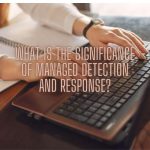A SOC analyst must be proficient in communication, coaching, and problem-solving. They must also operate efficiently under pressure and have superior analytical thinking skills. A skilled SOC analyst should also have strong organisational and problem-solving abilities in addition to these talents.

Investing in technology
Investments in technology can improve a company's productivity and customer service. These investments also assist businesses in expanding, reaching a larger audience, and reaching success milestones. For example, Facebook allows users to create business pages and ask customers to post information about their company. With these technologies, a company may swiftly expand, offer more items, and improve revenue.
However, technological investments can present specific difficulties. Many of the businesses experiencing this transformation are not yet profitable. This makes calculating their profitability using P/E ratios challenging. Investors should focus on sales growth when evaluating the profitability of such businesses. It is critical to highlight that an unprofitable company should be able to turn a profit as quickly as possible. Furthermore, a rising business should become more efficient while reducing marketing and sales spending.
Technology is getting more pervasive. More than two trillion dollars have been spent on innovative technologies during the last decade. This figure will likely rise to $2.4 trillion in the following years. Because it brings everything online and links billions of devices, the Internet of Things (IoT) is poised to be the most significant technological investment. While hardware investments benefit businesses in asset-heavy industries, software investments benefit businesses in asset-light industries.
Security policies that are formalised
A strong SOC should have clear security rules or guidelines outlining how the firm will address security alerts and other risks. These regulations should include a mandatory password requirement and other authentication criteria. They should also include any access tokens or biometrics required for specific systems. Employees should be contractually obligated to follow these rules. In addition, formal security policies should include recommendations for dealing with data breaches and other threats.
A security policy should be drafted clearly and concisely, considering that the intended audience is typically non-technical. Definitions of crucial technical words should also be included. Finally, it should specify the risk limitations and the acceptable level of risk. In other words, a security policy should be a management document that considers the firm's risk tolerance.
Security policies should be reviewed and modified regularly. This is significant since a faulty policy will erode the company's security safeguards. Security policies should be acknowledged by all personnel and regularly reviewed, in addition to being updated annually. The corporation should also rigorously adhere to it.
A decent SOC should be located within the facility in a safe room. To protect the space, physical barriers should be implemented. A strong SOC should also have a comprehensive collection of tools and technologies to safeguard information systems. A security information and event management (SIEM) system, an incident tracking system, a threat intelligence platform, and automation tools are among them.
A designated administrator should prioritise security in every organisation. Employees that follow security requirements should be able to be rewarded by this individual. Furthermore, firms should maintain a security help desk that provides security advice and solutions.
Making a strategy
Creating a good SOC plan necessitates the usage of numerous resources. A SOC must be capable of investigating occurrences and tracing the source of the problem utilising log data. Furthermore, cybercriminals' tools and techniques are constantly improving. As a result, it is critical to continuously improve the SOC to combat evolving threats. To do this, SOC should create a Security Road Map and implement hands-on procedures like red-teaming and purple-teaming.
A good SOC is established over time and involves both investment and knowledge. While no one-size-fits-all SOC exists, a few broad rules and tools might help you get started. The primary purpose of these resources is to give the foundation and understanding required to develop a strong SOC.
While there are other approaches to implementing a SOC, the most frequent is to create an in-house operation. Hiring an outsourced SOC or a managed team is another alternative. Although an in-house approach may appear to be the most convenient option, it can take time to establish a successful SOC and hire experienced employees. It also necessitates a distinct budget.
A SOC plan must include a clear statement of the mission and scope of the SOC. Finally, the SOC should assist a company in achieving its goals. It should detail the SOC's business-critical use cases and functional requirements. This will assist the SOC in proportionately developing its services.
Having an MSSP on call
An on-call MSSP can support your organisation, especially during significant occurrences or sicknesses. Furthermore, an MSSP can supplement the work of your SOC employees. An ideal MSSP will be able to speak with you and other staff members and monitor systems around the clock. Finding an MSSP with experience defending enterprises of your size is also critical. An MSSP should also be able to deliver reports daily, weekly, and monthly.
Another significant advantage of using an MSSP is having access to a seasoned team of security professionals. This ensures that your company complies with the most current industry requirements. An MSSP can also manage massive amounts of data simultaneously and around the clock. These skills will allow your organisation to concentrate on actual issues while reducing false positive notifications. A strong MSSP can give proactive support and remotely manage logs and alarms to identify and respond to threats.
Another advantage of having an MSSP on call is the low cost. MSSPs may be an attractive choice for firms that lack the in-house resources to handle security issues due to the cost savings associated with having a security team on call. Furthermore, the 24/7 oversight provided by an MSSP can assist firms in reducing dwell times, which can be critical when considering whether to adopt an MSSP.
Because of the worldwide nature of the Internet, attacks can occur at any time of day or night. This is especially true of ransomware, which frequently encrypts files as soon as it gains access to your machine. This is why your company requires extensive security measures. The two possibilities are an in-house security operations centre or a managed security services company.
Creating a budget strategy
A competent SOC will need to invest in the proper areas. A typical SOC might cost millions of dollars annually, and it can take many employees to do so. While this is a significant investment for many small organisations, it is still possible to replicate the capabilities of a typical SOC using alternate methods.
Creating a budget strategy entails calculating the amount of income the business is expected to generate. This budget should be built on assumptions, such as anticipated grants and gifts. It should also contain service and event fees. Once the budget is established, the team will need to decrease costs to meet the objectives.
The post What Are the Prerequisites to Make a Good SOC? appeared first on https://unterderbruecke.org
The post What Are the Prerequisites to Make a Good SOC? appeared first on https://gqcentral.co.uk



